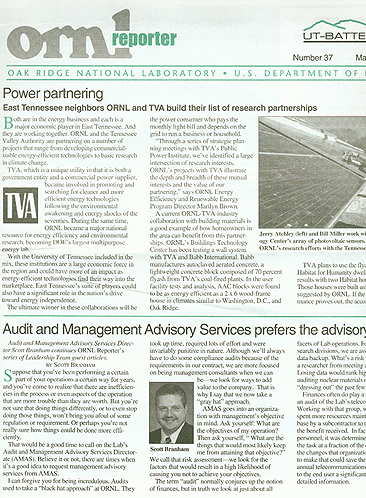 |
| Number 37, May 2002 |
 |
 Power partnering
Power partnering
East Tennessee neighbors ORNL and TVA build their list of research partnerships
Both are in the energy business and each is a major economic player in East Tennessee. And they are working together. ORNL and the Tennessee Valley Authority are partnering on a number of projects that range from developing commercial-izable energy-efficient technologies to basic research in climate change.
 |
TVA, which is a unique utility in that it is both a government entity and a commercial power supplier, became involved in promoting and searching for cleaner and more efficient energy technologies following the environmental awakening and energy shocks of the seventies. During the same time, ORNL became a major national resource for energy efficiency and environmental research, becoming DOE’s largest multipurpose energy lab.
With the University of Tennessee included in the mix, these institutions are a large economic force in the region and could have more of an impact as energy-efficient technologies find their way into the marketplace. East Tennessee’s suite of players could also have a significant role in the nation’s drive toward energy independence.
The ultimate winner in these collaborations will be the power consumer who pays the monthly light bill and depends on the grid to run a business or household.
“Through a series of strategic planning meetings with TVA’s Public Power Institute, we’ve identified a large intersection of research interests. ORNL’s projects with TVA illustrate the depth and breadth of these mutual interests and the value of our partnering,” says ORNL Energy Efficiency and Renewable Energy Program Director Marilyn Brown.
 |
| Jerry Atchley (left) and Bill Miller work with the Buildings Technology Center’s array of photovoltaic sensors. The experiment is one of ORNL’s research efforts with the Tennessee Valley Authority. |
A current ORNL-TVA-industry collaboration with building materials is a good example of how homeowners in the area can benefit from this partnerships. ORNL’s Buildings Technology Center has been testing a wall system with TVA and Babb International. Babb manufactures autoclaved aerated concrete, a lightweight concrete block composed of 70 percent flyash from TVA’s coal-fired plants. In the user facility tests and analysis, AAC blocks were found to be as energy efficient as a 2 x 6 wood-frame house in climates similar to Washington, D.C., and Oak Ridge.
TVA plans to use the flyash AAC wall system in a Habitat for Humanity dwelling and compare the results with two Habitat houses built in Lenoir City. Those houses were built using efficient technologies suggested by ORNL. If the wall system’s performance proves out, the accomplishment will be twofold: a new, more energy-efficient technology for low-cost housing and a waste product from coal burning—flyash—productively recycled.
The BTC is also working with TVA and a host of other firms and organizations on the Photovoltaic Green Power Switch Project. The south face of the BTC’s Envelope Systems Roof Apparatus has been fitted with sensors and photovoltaic solar collectors. The BTC’s Bill Miller is running the project, which he calls “a shady proposition” in that one of the study’s goals is to determine the effect of shading from the photovoltaic arrays on the energy use of the building. “Shading from the arrays provides an ancillary benefit to the building by lessening the demand for air conditioning,” Bill says. “Typical roof temperatures on a hot sunny day exceed 160ºF. By shading, we are dropping that to slightly above the outdoor temperature.”
Localized power generation sometimes comes with an environmental penalty, however. Diesel-powered generators and other reciprocating engines emit particulates that have potential health effects. TVA has supported ORNL research by John Story, Mengdawn Chen and others to develop a portable device to investigate responses of human lung cells to airborne particles. Tiny, ultrafine airborne particles from pollutants can penetrate deep into lung tissue, much like a gas. As the use of on-site portable generators increases, utilities are becoming more interested in what the mechanisms behind potential health effects are.
TVA has also participated in the Walker Branch Watershed area’s long-established throughfall displacement experiments, in which researchers manipulate rainfall to simulate various climatic conditions. TVA has helped fund climate-change research on the effects on root development in response to differences in moisture.
Power consumers are getting closer to having super efficient appliances and lighting available to them, thanks to the ORNL-TVA partnerships. A recent TVA publication featured two marketable appliance technologies developed in the BTC—the frostless heat pump and heat-pump water heaters.
The frostless heat pump, developed by a BTC team led by Fang Chen, reduces coil frosting on the heat exchangers of outdoor units. Coil frost reduces a heat pump’s efficiency and performance. Besides increasing operating cost, the frost also compromises the comfort levels inside the building, resulting from the “cold blow” heat pumps are sometimes noted for. The frostless units also reduce surges in power consumption caused by defrosting. TVA and Amana Heating & Air Conditioning are sponsoring tests of frostless units in homes this summer.
The heat-pump water heater, currently in the prototype stage, has shown that it can be twice as efficient as conventional water heaters by taking advantage of heat from the air to heat water. One prototype model developed by ORNL and its industrial partners, EMI and A.D. Little, has a heat pump stationed on top of the water tank. TVA is also interested in a “bayonet” design that replaces the heating element in an electric water heater. The utility plans to run a field study of heat-pump water heaters in two Knoxville residences this year.
 |
| TVA has participated in ORNL’s hybrid lighting project. |
Hybrid lighting is a technology that uses optical-fiber technology to help illuminate the interiors of buildings with light from the sun. There’s no better energy deal going than sunlight, obviously, if you can use it. According to Jeff Muhs, the principal investigator in the Engineering S&T Division, TVA has helped fund the fabrication of the luminaires, or light fixtures, used in the experiments.
The reliability of the power grid is an area of mutual interest for TVA and ORNL. The utility will be working with ORNL to field test new composite conductors that promise to eliminate transmission bottlenecks in East Tennessee and across the nation. High-capacity advanced conductors for electricity transmission will be deployed on a transmission test facility that ORNL’s Engineering S&T Division will set up this summer. The facility, on Old Bethel Valley Road, will subject the advanced materials to an accelerated regime of high temperatures, sag and tension. “TVA is among many utilities that stand to gain with power consumers if the improved transmission lines prove out and transmission capacity can be expanded on existing lines,” says ESTD’s Brendan Kirby, who is working with John Stovall, Tom Rizy, Roger Kisner and Mike Karnitz on the project.
Finally, ORNL is TVA’s first industrial “green power” customer, an agreement they reached in 2000. The wind turbines whirring atop a ridge visible from parts of Oak Ridge generate some of TVA’s “green” power; the remainder comes from photovoltaic systems (like the one at the BTC) and trapped landfill gas. Although the amount of “green power” provided by TVA serves only a small fraction of the Lab’s demand, the arrangement sets an important precedent for alternative energy technologies.
Lab Director Bill Madia noted the example the two institutions were setting when the agreement was inked two years ago. “This is a great example of using leading-edge technologies from ORNL that can improve our environment for our children’s future,” he said.
“I’m really pleased with the partnerships we’ve forged since that agreement was signed,” he says, two years later.—B.C., with Marilyn Brown
 Audit and Management Advisory Services prefers the advisory role
Audit and Management Advisory Services prefers the advisory role
Audit and Management Advisory Services Director Scott Branham continues ORNL Reporter’s series of Leadership Team guest articles.
| by Scott Branham |
 |
| Scott Branham |
Suppose that you’ve been performing a certain part of your operations a certain way for years, and you’ve come to realize that there are inefficiencies in the process or even aspects of the operation that are more trouble than they are worth. But you’re not sure that doing things differently, or to even stop doing those things, won’t bring you afoul of some regulation or requirement. Or perhaps you’re not really sure how things could be done more efficiently.
That would be a good time to call on the Lab’s Audit and Management Advisory Services Directorate (AMAS). Believe it or not, there are times when it’s a good idea to request management advisory services from AMAS.
I can forgive you for being incredulous. Audits used to take a “black hat approach” at ORNL. They took up time, required lots of effort and were invariably punitive in nature. Although we’ll always have to do some compliance audits because of the requirements in our contract, we are more focused on being management consultants when we can be—we look for ways to add value to the company. That is why I say that we now take a “gray hat” approach.
AMAS goes into an organization with management’s objective in mind. Ask yourself: What are the objectives of my operation? Then ask yourself, “ What are the things that would most likely keep me from attaining that objective?” We call that risk assessment—we look for the factors that would result in a high likelihood of causing you not to achieve your objectives.
The term “audit” normally conjures up the notion of finances, but in truth we look at just about all facets of Lab operations. For instance, in the research divisions, we are assessing the adequacy of data backup. What’s a risk factor that would prevent a researcher from meeting a scientific objective? Losing data would rank high on the list. We are also auditing nuclear materials operations and have been “dressing out” the past few weeks.
Finances often do play a role. We just completed an audit of the Lab’s telecommunications program. Working with that group, we discovered that the Lab spent more resources maintaining a separate database by a subcontractor to track telephone costs than the benefit received. In fact, working with SAP personnel, it was determined that SAP could handle the task at a fraction of the cost. In all, we supported the changes that organization’s management wanted to make that could save the Lab up to $300,000 in annual telecommunications costs, as well as provide to the end user a significantly increased level of detailed information.
That project is a good example of an organization seeing how it could change to benefit the Lab. In other instances it appears that the Lab practices accounting as an exact science and thus spends a lot of time chasing pennies. We see a lot of people “sweating the small stuff” and missing opportunities to increase economies and efficiencies. What I often see is “we had a problem, we put in a control, took another look or had another audit, put in another control …” and pretty soon we become overcontrolled instead of looking at the operation’s objective to see how we can balance risk and management controls. It’s common all over—we spend more on the controls than we do on the function, similar to what we found when we looked at the telecommunications operation. I’m not averse to removing controls as long as the risks are effectively managed.
The audit process starts—not with men in dark suits and dark glasses standing at your door with helicopters flying overhead—but with an entrance meeting. It helps to be able to sit down with us and tell us what your group’s objectives are. You can help us identify risks that would prevent you from meeting those objectives. It’s more than adding up numbers—we look at processes and inefficiencies.
Following that, we’ll do a preliminary survey in which we review documents and interview people who are familiar with the processes. This is where we may identify risks beyond what were discussed in the initial meeting. We have also started getting all responsible parties in a room together and recording management’s objectives and identifying risks and controls as a group. This has expedited the audit process.
During the field work, we perform tests and analyses to determine whether objectives are being met and whether management controls are working as intended. If any issues are noted, Control Improvement Opportunity memos may be generated that outline the condition, its cause and effect and suggestions for improvement. Likewise, we note any best practices and noteworthy accomplishments in the final report that were identified during the audit.
If management chooses, we have an exit meeting to discuss what is and is not working well and discuss recommendations for improvement with the organization’s management. These are normally being waived because of the constant communication during the course of the audit. We strive to obtain management’s concurrence prior to the issuance of any type of written documents. After all discussions are held, the final report is presented to ORNL and DOE management. We incorporate management’s comments into the report, as well as their corrective actions or action plan. We do require that a date be set for completion, since actions are tracked in the Lab’s tracking system. During followup, we verify that the corrective actions are complete and that there is a process in place to ensure that the corrective actions remain effective.
Of course, we sometimes have to put on our black hats during an investigation. AMAS is also responsible for conducting ethics investigations which relate to potential waste, fraud and abuse.
The Office of the Inspector General performs a limited peer review annually to look at what we’ve done and make sure that management is taking steps to remedy issues from our suggestions for improvement. We follow the Standards for the Professional Practice of Internal Auditing issued by the Institute of Internal Auditors. We also have an external peer review conducted every three to five years to ensure we are operating the function in accordance with industry standards. Most large companies and government contractors have operations similar to ours. My own objective is to identify cost-saving opportunities equal to the budget of AMAS.
Every year AMAS makes up a schedule of audits to perform. However, we prefer to perform management advisory services. These come in the form of management requests related to financial, managerial, operating, and risk management issues. We allow time in the annual planning process to perform these services. If you believe your organization or operation could benefit the company through changes in processes, call us in on the front end. We’ll sit in on your process change and help you make it a truly value-added process.
Be proactive, not reactive. It’s much more cost effective. Visit our website at http://home.ornl.gov/offices/audit_management_advisory_services/.
 Beam at the end of the tunnel
Beam at the end of the tunnelIt’s almost literally the light at the end of the tunnel, but call it a beam. A ceremony at Lawrence Berkeley National Lab in California May 2 was also big news in Oak Ridge. Berkeley Lab, one of the six Spallation Neutron Source partnering labs, dedicated the SNS front end, making Berkeley the first of the partners to deliver on its piece of the project.
The “front end” is where the SNS’s ion beam will originate. The proton beam will eventually strike a mercury target, “spalling” neutrons that will then provide researchers with the most intense pulsed beams of neutrons available anywhere.
A key component of the front-end system is its radio-frequency quadrupole, or RFQ, accelerator. To save costs, the Berkeley team built the production RFQ without a prototype, a bold strategy in that RFQ accelerators are something like a box of chocolates.
The senior team leader of Berkeley’s SNS Front-End group, Rod Keller, explained after a successful January test: “This is risky business with an RFQ accelerator because you never know what you have until you test it. Either your accelerator works or it doesn’t, and in this case it worked extraordinarily well!”
The RFQ produced a 2.5 million electron volt beam at a current of 24 milliamps on its first try, which was deemed already sufficient to support SNS operation at 1.2 megawatt average power.
In other words, the plan is coming together. Following its commissioning at Berkeley, the front end will arrive at the Chestnut Ridge site probably sometime in June. Besides ORNL, the other partner labs are Argonne, Brookhaven, Los Alamos and Jefferson Lab.
 Parking and traffic update: Humps, not bumps
Parking and traffic update: Humps, not bumps
The latest on parking at ORNL is that the switch to an open campus, in which employees would be pretty much free to drive and park inside the fences, is probably going to be delayed several months. Originally planned for this summer, the open campus is being delayed mainly because new parking spaces inside the fence haven’t been constructed. “All the new planned parking lots aren’t scheduled to be ready for about a year from now, and Lab management decided that without the full complement of parking being available, we might have a bigger parking hassle than we do now,” says Modernization coordinator Tim Myrick.
In the meantime, traffic planners are studying the best ways to get around the Lab, and do it safely. One plan is for the installation of raised crosswalks and speed “humps” at strategic locations. Note that we say humps and not bumps—the traffic controls won’t be bone rattlers, but they will be sufficient to keep speeds at or below the 25 mph Lab limit.
As far as getting to the Lab goes, the new vehicle portals on Bethel Valley Road should be completed and open by the middle of May. The new entrances are designed so that extra entry lanes can be established during peak times. The new portals come with a new requirement for those passing through—when they go into operation, all passengers inside vehicles will be required to produce DOE badges or an ORNL-approved credential such as a drop-off/pick-up pass. This is a change from the one-badge-per-vehicle requirement established when Bethel Valley Road was first closed to the public at the end of last year.
Finally, last month’s warning that local law enforcement officials might help calm traffic on Bethel Valley Road—a response to numerous employee concerns expressed about speeding—is now fact. A heavy foot could be expensive.
|
||
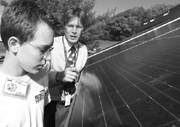 |
More than 300 children, all with ORNL employees as parents, visited the Lab on April 25, the designated Take Your Child to Work Day. Bill Madia hosted an opening ceremony that included a science quiz and a talk on safety by Tim Myrick. Kids also had an opportunity to see ORNL’s supercomputing facility and do hands-on drawing with a robot at Robotics. At the cafeteria there were fun things to do with liquid nitrogen—the funnest probably being making ice cream with it, as Bill demonstrated. A followup on the ORNL Website is planned: check the site at www.ornl.gov/cfw/tyc2002/.
|
 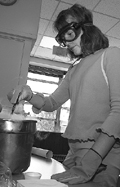 |
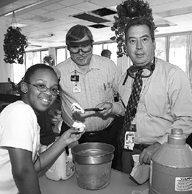  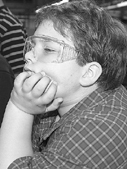  |
||
| —Reported by Bill Cabage |
 ORNL people
ORNL people
The Physics Division’s Terry Clayton Awes has been elected a fellow of the American Physical Society, “for his leadership in the discovery of direct-photon emission in relativistic heavy-ion collisions as a way to search for the quark-gluon plasma, and for his leadership as spokesman of CERN heavy-ion experiment WA98.”
The National Urban League has honored Ella Dubose of the Staffing Management and Diversity Programs Division for her work in its Black Executive Exchange program. Ella’s Five-Year Milestone Award “recognizes her efforts on behalf of the educational advancement of college students who have participated in the exchange program.”
Yoon-Ho Kim, a Wigner fellow in the Computer Science and Mathematics Division, has received honorable mention in the Association of Korean Physicists in America’s Outstanding Young Researcher awards. Yoon-Ho, one of only four honorees in the 2002 program, was cited for his work in the field of quantum optics, especially in quantum computing and information science and technology.
Glen Harrison of the Engineering Science and Technology Division has been appointed to the International Advisory Board of the Korean Federation for Environmental Movement, in recognition of his years of service as an advisor and editor with applications for research grants, and especially for his contributions to the implementation of KFEM’s small grant program. KFEM is the largest nongovernmental environmental organization in Korea.
The Metals and Ceramics Division’s Lance Snead has been awarded the first Miya-Abdou award “in recognition of outstanding technical contribution to the field of fusion nuclear technology.”
ORNL publications and art won a number of awards at the East Tennessee Chapter of the Society for Technical Communications award ceremony, including both best-of-show awards: For publications, Genomes to Life: Accelerating Biological Discoveries, by Judith Wyrick, Elizabeth Martin, Denise Casey and others; for art, From Science to Market, by Tina Curry, LeJean Hardin and Walter Koncinski.
The Spallation Neutron Source’s Kathy F. Rosenbalm is the 2002 Administrative Professional of the Year, awarded by the International Association of Administrative Professionals. Kathy was nominated by SNS Associate Laboratory Director Thom Mason.
 Spring is the busy season for Team UT-Battelle volunteers
Spring is the busy season for Team UT-Battelle volunteers
Things tend to get busy in the spring, and Team UT-Battelle is no exception. Here’s a sampler of ORNL staff members’ involvement in volunteer projects, including what’s been going on and what’s ahead.
Good times for March of Dimes
Team UT-Battelle collected more than $1,500 for the March of Dimes Anderson County WalkAmerica on April 13 at the Oak Ridge Marina. Thirteen Team UT-Battelle members donned their green T-shirts and walked the five-mile distance along Melton Hill Lake. Twenty Team UT-Battelle members raised money for the cause, tripling last year’s contribution. The Atomic Trades and Labor Council raised more than $6,200 for the effort—the leading collecting organization for the walk. Overall, the walk raised more than $38,000.
Taking out after trash
Team UT-Battelle volunteers gathered to pick up trash along Highway 95 near the intersection of Bethel Valley Road on Thursday evening, May 2. Participants received Team UT-Battelle and Keep Roane Beautiful T-shirts, gloves and orange vests. Volunteers were also treated to a short safety session before work began and a light dinner after the event.
RFL volunteers use feet … and heart
Many ORNL employees have volunteered for the Anderson County Relay for Life on Friday, May 10, starting at 6 p.m. and running through 10 a.m. Saturday, May 11, at the Anderson County High School track and football field. Team captains are Evelyn Angel, Faye Brewer, Roberta Grafton, Jim Hackworth, Carol Leffew, Kaye Johnson, Mary Kiser, Claudette McKamey and Kathie Shearer.
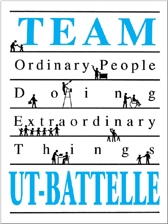 |
Straight arrows
A group of ORNL volunteers put together a “shoot team” to assist with the Archery Shooter’s Association National Pro-Am Tournament, held in Oak Ridge April 12–14, at the Oak Ridge Sportsman’s Association grounds. The event drew archers from all over the country and about 3,000 visitors, says organizer Pat Parr. Volunteers helped by setting up ranges and targets, directing parking and providing other logistics.
Clear focus
Sheri Coffey, Team UT-Battelle project director for Recycle Your Vision, reports ORNL employees donated 240 pairs of eyeglasses to the Oak Ridge Lions Club in April. This brings a total of 12,467 pairs of eyeglasses recycled by ORNL since this effort began in 1994.
Walk to Cure Diabetes
On Saturday, May 11, Team UT-Battelle volunteers gather at Volunteer Landing in Knoxville for the 2002 Walk to Cure Diabetes, sponsored by the Juvenile Diabetes Research Foundation. Walkers have asked relatives, friends, neighbors and co-workers to sponsor them in the walk by making a contribution to the Juvenile Diabetes Research Foundation for vital research to find a cure for diabetes and its complications.
Play ball!
In a prelude to the JDRF walk, a Leadership Team squad led by Lee Riedinger was set to go up against a collection of alleged ringers called “The Other Guys,” coached by Frank Kornegay, in the second annual JDRF baseball game at Clark Center Park on May 6. The ’Guys won last year’s contest against the “Suits” 15–10, a margin characterized at the time as “unexpectedly close” and “largely due to the umpiring.” No score to this year’s contest was available at press time, which is probably just as well.
Melton Hill’s bonny banks
Ten Team UT-Battelle volunteers, captained by Judy Benton, set sail at Clark Center Park on April 6 to clean up Melton Hill Lake shoreline. It was part of the annual River Rescue sponsored by TVA and Ijams Nature Center. F&O’s Steve Lewis is an annual organizer for the Melton Hill rescue. Fort Loudon Marina donated the boat; Team UT-B donated lunch. By day’s end the crew had pulled a heaping mound of garbage off the banks, including enough old tires to make a set.
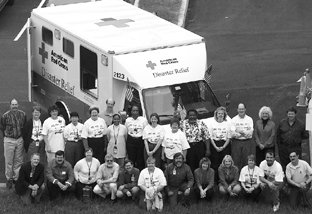 |
| Some of the donors for the Red Cross disaster recovery van posed in front of a similar van that was on view at the Lab during the campaign. Employees donated more than $10,000. |
Red Cross Van drive rolls
The week of April 22 was Red Cross Disaster Relief Van Campaign Week (see the April Reporter). ORNL staff came through—they always do—with more than $10,000 toward the $65,000 it will require to purchase the van for the local Appalachian Chapter. Organizer Tim Myrick, a veteran of many volunteer relief efforts, will match the employees’ contribution; he’s also receiving support from UT-Battelle, BWXT/Y-12, Bechtel Jacobs, SAIC and Duke Engineering and Services.
Bluebirds’ buddies
Team UT-Battelle supported the annual Wildlife Habitat Building event at the American Museum for Science and Energy. John Jordan and Wayne Parker helped visitors put together bluebird houses. This year, more than 230 kits were sold to provide housing for our eastern bluebirds, which are permanent residents in Tennessee. Since AMSE has been having this annual event, more than 12,000 bluebird houses have been sold.
Pinewood pacers
Twenty-eight Cub Scouts from the Pellissippi District of the Great Smoky Mountain Boy Scout Council gathered at the American Museum of Science and Energy on Saturday, April 13, to compete for the 2002 Pinewood Derby Championship. The race was sponsored by the American Society of Mechanical Engineers, Team UT-Battelle and the American Museum for Science and Energy. Pinewood Derby winners were Tim Geist, first place, and Max Perry, second place, both from Pack 123; and Dakota Roach, third place, from Pack 120.
Help for the Smokies
Finally, Team UT-Battelle is joining with BWXT/Y-12 to resume one of the more popular volunteer efforts in past years—Help the Smokies. This year volunteers will work on rehabilitating parts of the Cades Cove picnic area, a popular Great Smoky Mountains National Park spot that takes a pounding from tourists each year. The first work day is May 18. Contact Kim McMahan, 576-1566, if you’d like to participate.—B.C., with Brenda Hackworth
 Pioneer stock
Pioneer stock
Don Trauger’s memoir offers a perspective on the transition from a horse-drawn age to the nuclear era
If you lived in the middle part of the 20th century, you witnessed one of the most incredible periods of human technical advancement, particularly in terms of the production and uses of energy. Former ORNL associate director Don Trauger’s just-published book of life experiences spans a period of history in which technology progressed with head-spinning rapidity.
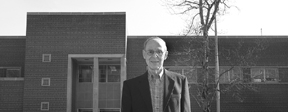 |
| Don Trauger’s time at ORNL has been a stop along a way that ranges from the pioneer era to the nuclear age. |
It’s the sort of story many people currently in their 80s can tell—for instance, my Camry-driving mom, who is the same age as Dr. Trauger, spent part of her childhood in a logging camp near what’s now the Citico wilderness, accessible only by horse or steam locomotive. Trauger offers a bonus: His work includes sagacious views on the important energy choices the nation and world must make toward a secure future.
Horsepower to Nuclear Power: Memoir of an Energy Pioneer (Providence House Publishers, $28.95) covers the mid-1800s to the present with an energy theme packaged inside a fascinating personal memoir. Trauger comes from the Midwest, from pioneer agrarian stock—his forebears migrated to the Great Plains in covered wagons and lived initially in sod houses. They watched the railroad come through and the towns rise alongside. They built real houses and farmed. It was a hard, happy life.
Don’s own beginnings were precarious: He was a premature baby who had to be revived at birth. His boyhood, though sometimes sickly, seems placid enough (although he had several narrow escapes from farm accidents and a pet rooster that attacked hapless strangers). Exeter, Nebraska, was the kind of town where a Protestant’s volunteering to fix a Catholic church’s storm-damaged spire, as his father did, would raise eyebrows. His mother was a “study in energy” who smashed bootleggers’ stashes when she found them on their farmland. He recalls an uncle’s gift of a “thorium-mantle-type lantern.”
The Trauger extended family apparently fed Don’s inquisitiveness. He twiddled his mother’s sewing machine to dysfunction until she scared him away by tying a feather to it; a phobia that endures, he says, to this day. Later, Don observed how the plowhorses toiled to till the earth and later noted the difference motorized farm tools and other conveyances made in his community.
The Great Depression was, as it was for most of that generation, a formative event for Trauger. As a midwesterner, he also had to contend with the drought-stricken ’30s and the period’s dust storms (see excerpt), an ecological disaster that he blames on poor farming practices. Trauger’s own great depression came at graduation from high school at age 15 with the realization, for all he knew, that the end of his formal education had arrived.
The good student nevertheless eventually enrolled in Nebraska Wesleyan College, where he was blessed with a plethora of inspiring and influential instructors. He was drawn toward physics and, remarkably for the late ’30s, dwelled upon the growing use of fossil fuels, which seemed in finite supply even then. It was his/our great fortune that he was in the middle of an atomic physics course when the news of the discovery of uranium fission came in 1939. He read an article about it in Physical Review authored by Herbert Anderson, E.T. Booth, John Dunning (a Wesleyan alumnus), Enrico Fermi, G.N. Glassoe and F.G. Slack, all of whom he would meet in the near future.
Trauger says that, at the time, even then, thoughts in the popular science press turned to its potential as a source of energy. He thought so too, but recognized the problems that radiation posed. At any rate, his enthusiasm for the new science marked his final months as an undergraduate.
War’s outbreak and Germany’s perceived head start in atomic science turned thoughts toward nuclear weapons. Don, meanwhile, had gone back to the farm for the summer of 1942. One day, in mid-August, his mother called him to the phone. So here’s the scene: A gangly farm boy in sweat-stained clothes approaches the mouthpiece of a hand-cranked telephone to receive, apparently out of the blue, Dunning’s invitation to Columbia University to work on a “secret project” that would be “challenging, interesting, and important to the war effort.” Someone must have noticed him at Nebraska Wesleyan.
It is difficult to envision history being made that way—the melding of two ages, horse and nuclear—ever again. Perspectives from people with that range of experience are also becoming hard to come by. It’s fortunate that Don Trauger’s story and his views have been set into print. —B.C.
 Seaborg’s son describes dad as a humble, hard worker
Seaborg’s son describes dad as a humble, hard worker
Glenn Seaborg, the Nobel Prize-winning discoverer of plutonium and once chairman of the U.S. Atomic Energy Commission, was probably the foremost chemist of the 20th century. But did he have a big ego?
His son Eric, who spoke at the Friends of ORNL’s April 25 community lecture, says he did have an ego but his six children kept it under control by poking fun at him. For example, when he learned in 1951 he had won the Nobel Prize, he immediately told his family. His oldest son, then six years old, asked, “Has anyone ever won two?” Seaborg pondered the question, at first said no, and then corrected himself.
“Marie Curie won two Nobel prizes, ” he said.
Replied his son: “A girl? ”
Eric, who is a freelance science writer, offered to help his father write a popularized autobiography after his father dashed off the first draft in two weeks and sent it to Eric. Eric interviewed his father, reviewed his books and 40 volumes of diaries (started when Glenn was 14), and finished his autobiography after Glenn died in 1999.
Eric said that Glenn never forgot his Swedish-American roots in a Michigan mining town and was amazed that he had become a world-renowned figure who ran the University of California at Berkeley, revised the periodic table and advised nine U.S. presidents. Several lucky breaks helped his career, Eric said, but Glenn also surrounded himself with people he considered smarter than himself and worked harder than they did.
The book is titled Adventure in the Atomic Age: From Watts to Washington. —Carolyn Krause
 Haire, Dale, Geist named UT-Battelle corporate fellows
Haire, Dale, Geist named UT-Battelle corporate fellows
 |
 |
 |
|
|
|
|
Corporate fellowships recognize exceptionally gifted individuals throughout the organization for their technical achievements in science or engineering. A UT-Battelle Senior Corporate Fellowship is the highest ranking research position at ORNL.
Dick Haire has had a long and productive career in investigating the fundamental chemistry of transplutonium elements. He’s recognized as a pioneer and leader in his field. He has published more than 300 papers. Those who have cited Dick’s work include the late Glenn Seaborg, the discoverer of plutonium.
Dick’s entire professional career has been spent at ORNL, beginning in 1965. His work has been especially notable for pioneering studies with transplutonium elements from americium through mendelevium. More recently his collaborations in the study of high-pressure behavior of the actinides, the family of elements 89 through 103, are having profound impact on the field of heavy-element chemistry.
Virginia Dale has been at the cutting edge of disturbance ecology, landscape ecology and environmental decisionmaking. Her research has influenced some of the largest land holders in the world, including the U.S. Forest Service and the Department of Defense, and she has helped form the Environmental Protection Agency’s landscape ecology research program.
Virginia was one of the first to investigate the aftermath of the 1980 eruption of Mount St. Helens in Washington, producing a major contribution to the understanding of disturbance ecology that is ongoing. She was one of the first scientists to undertake quantitative analysis of land-use change and its implications to global change, and her approaches to modeling land-use change has been applied in Brazil, Guatemala and Panama.
Virginia has served on numerous environmental science-related panels and committees and has written three books and more than 140 journal articles and has given 118 invited scientific presentations. Her work since 1992 has been cited at least 565 times in scientific literature.
Al Geist is an internationally recognized computer scientist, particularly in the areas of distributed and cluster computing. His fame stems from the development of the Parallel Virtual Machine, which permits a cluster of computers to be used as a single large parallel computer. PVM users can solve bigger computing problems using available hardware.
Al joined the Lab in 1983 and quickly made significant contributions in the area of nonlinear phenomena in laser ablation. Later, he wrote the first parallel version of the High Tc code for the Superconductivity Grand Challenge, which led to the prestigious Gordon Bell Prize in 1990. He also single-handedly won two of the ten Energy 100 Awards—the top 100 discoveries and innovations from DOE that have benefited consumers—that ORNL received last year. They were the PVM and the Electronic Notebook.
He has authored more than 150 scientific papers, one book and six chapters in others and has been cited in scientific literature more than 1,000 times in the last five years.—B.C.
 U.S. Savings Bonds: Save patriotically in May
U.S. Savings Bonds: Save patriotically in May
One way to show your patriotism is to buy U.S. Savings Bonds. ORNL’s annual savings bond drive runs through Friday, May 17. This year’s theme is “Save for your future.” Savings bonds are a safe and convenient way to save money, and they help the country because they directly help finance the nation’s borrowing needs.
Co-chairs for this year’s campaign are Jamie Johnson and Danny Cantrell; Terry Jackson, ATLC chairman; and Linda Moyer, ATLC coordinator.
Volunteer canvassers and coordinators will be contacting employees on their U.S. Savings Bonds participation. Information on U.S. Savings Bonds is available on the Web at www.savingsbonds.gov.
 Service award program eligibility includes part-timers
Service award program eligibility includes part-timers
ORNL Employee Benefits has extended employee eligibility for the service award program to include all part-time employees. This change will be effective for company service award anniversaries beginning April 1, 2002, says Benefits Communications Coordinator Kathryn Cogar. As before, regular full-time employees are also eligible to receive service awards. For more information about the Service Award program, go to the “New Service Award Program” Web page (home.ornl.gov/~bnp/newServAward.htm) or call 574-7474.
 Wigner’s legacy continues; ORNL greets new postdoctoral fellows
Wigner’s legacy continues; ORNL greets new postdoctoral fellows
ORNL’s Wigner Fellowship program has named four new postdoctoral researchers; three of them are already doing research at the Lab. The Eugene P. Wigner Fellowship program was established in 1975 to honor the Nobel Prize winner and first director of research at ORNL. This year marks the 100th anniversary of his birth.
The two-year fellowships have attracted exceptional young scientists to ORNL over the years. The program makes it possible for outstanding scientists and engineers to continue on the developmental path. Over the years, many of these young researchers have remained at ORNL.
At a reception for new, current and past Wigner fellows on April 23, Bill Madia noted the program’s value to the fellows and Lab alike. The fellowships, he says, are an opportunity for Wigner fellows to work with some of the world’s best scientists on the most complex and challenging problems and to work in one of the world’s best facilities. Attracting the young researchers “is of great benefit to the Laboratory—a wonderful and enriching experience for ORNL.”
Bill recognized Brookhaven National Laboratory’s Ralph James at the reception. Ralph was a Wigner fellow who was recently named an associate lab director at Brookhaven.
Also recognized at the reception were Liane Russell, a Wigner Fellowship committee member and Fermi Award winning researcher at ORNL who retired late last year, and the late Sheldon Datz, the former committee chairman and longtime supporter of the Wigner Fellowship program, who received the Fermi Award in early 2001. He died in August of last year. His widow, Jonna Datz, accepted the plaque.
The four new Wigner fellows are
 |
 |
 |
|
|
|
|
Robert Grzywacz most recently completed a two-year teaching and research position at the Institute of Experimental Physics at Warsaw University, Poland, where he received his doctorate in physics. He previously served in a two-year postdoctoral assignment at the University of Tennessee, where he worked in the radioactive ion beam research program and conducted supporting research at ORNL’s Holifield Facility. In 1995 he was awarded a prestigious scholarship for young researchers by the Foundation for Polish Science. Robert is now working with Cyrus Baktash in the Physics Division, where he will continue to work on studies of the nuclear structure of unstable nuclei.
Yoon-Ho Kim received his Ph.D. in physics from the University of Maryland in May 2001. His publications as a graduate student (12 journal articles as lead author, including three in Physical Review Letters) were primarily within the field of experimental quantum optics, with a focus on quantum information science. At ORNL, he is working in the Computing and Computational Sciences Directorate with Jacob Barhen.
Maria Varela, who will soon arrive at ORNL (thus we have no photo), received her Ph.D. in solid state physics from the Complutense University, Madrid, in July 2001, where she excelled in the field of materials science. She has experience in the growth, physical properties measurements and structural characterization of thin films, in particular high-temperature superconducting thin films and superlattices. Maria will be working with Stephen Pennycook’s group in the Solid State Division, where she will be applying scanning transmission electron microscopy to cutting-edge materials research to determine atomic and electronic structure of interfaces in materials.—B.C.
 Got a story?
Got a story?
Research, opinions, activities—do you have a story that you would like to share with
your co-workers? Let ORNL Reporter know. Call or e-mail Bill Cabage (574-4399, cabagewh) or Deborah Barnes (576-0470, barnesds).
ORNL office: P.O. Box 2008, Oak Ridge, TN 37831-6146, Building 4500-S, Room F-60, MS 6146
ORNL help line (ethics; fraud, waste and abuse; quality; ES&H)
576-9000
��[an error occurred while processing this directive]
[an error occurred while processing this directive]
Bill Cabage, lead editor, ORNL, 574-4399 (cabagewh@ornl.gov)
Deborah Barnes, associate editor, 576-0470 (barnesds@ornl.gov)
Ombudsman: 576-7802
��
DOE inspector general hotline: 1-800-541-1625
